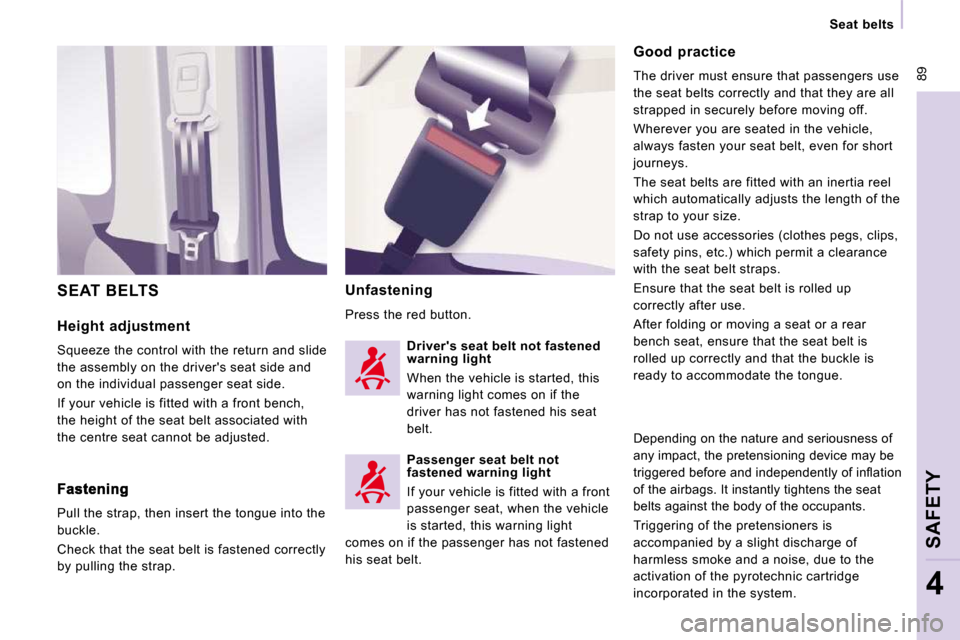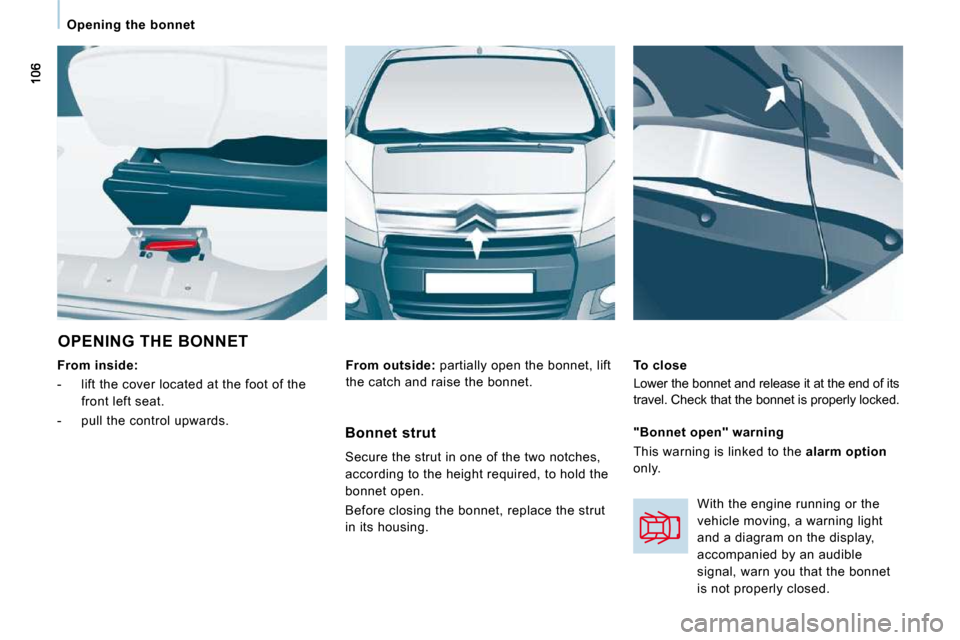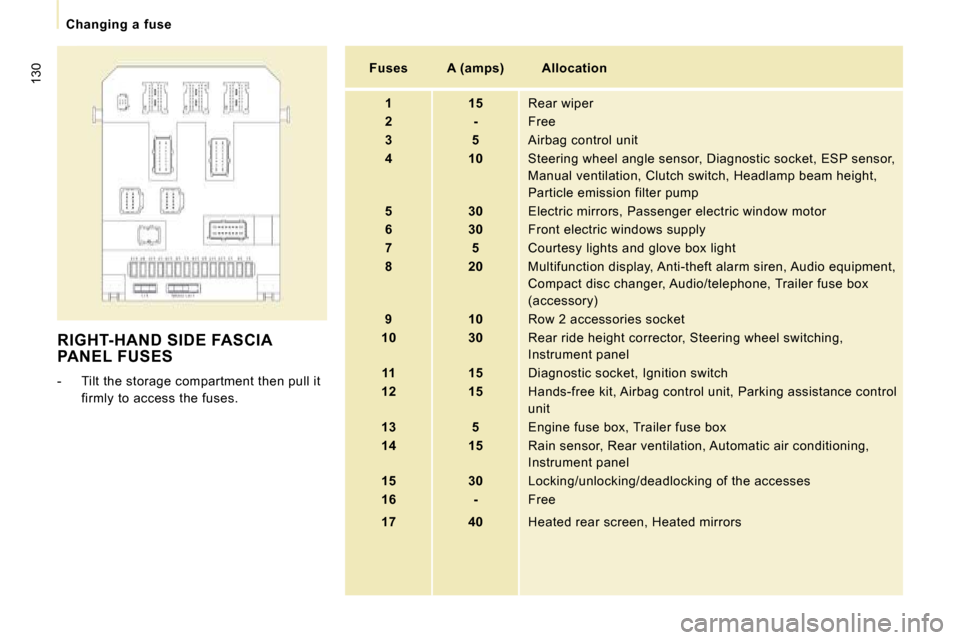height Citroen JUMPY MULTISPACE 2010 2.G User Guide
[x] Cancel search | Manufacturer: CITROEN, Model Year: 2010, Model line: JUMPY MULTISPACE, Model: Citroen JUMPY MULTISPACE 2010 2.GPages: 235, PDF Size: 11.2 MB
Page 85 of 235

80
Instruments and controls
2 - Manual correction of the height of the rear sill
If your vehicle is fitted with this adjustment,
the control is located on the right-hand side
at the rear of the vehicle.
This manual adjustment permits "lowering"
or "raising" of the height of the sill of the rear
platform to facilitate operations in a parking
area.
This adjustment of the height of the sill is
restricted by a lower limit and an upper limit. First use
To initialise the function, press the control
for approximately 2 seconds.
Operating faults
If the load sill is not adjusted when the
control is pressed, "3 bleeps" indicate a
malfunction for the following reasons:
- foot on the brake pedal with the key in
the ignition,
- excessive use of the manual correction,
- low battery charge,
- failure of the system.
If the audible signal persists, contact a
CITROËN dealer.
Carry out these operations with the vehicle
still stationary and:
- with the front and side doors closed,
- with the handbrake applied,
- do not leave your foot on the brake
pedal.
Lower: downwards adjustment
of the platform sill
Press the control downwards
continuously.
Release the button to stop the movement,
"3 bleeps" indicate that you have reached
the maximum limit, the movement stops
automatically.
Raise: upwards adjustment of
the platform sill
Press the control upwards
continuously.
Release the button to stop the movement,
"3 bleeps" indicate that you have reached
the maximum limit, the movement stops
automatically.
Return to the optimum sill height
Press the control up or down twice in
succession, the opposite of the position of
the load sill.
Page 86 of 235

81
Instruments and controls
EASE OF USE and COMFORT
3
Deactivation of the manual correction Good practice
When stationary and with the ignition key
removed, excessive use of the system
consumes battery charge. Parking for a long duration
Avoid parking for a long duration on ground
which could present a potential obstacle as
your vehicle could lower.
Following a long period out of use, the
height of the platform may change due to the
automatic compensation on unlocking or on
opening one of your vehicle's doors.
With the vehicle stationary:
- press and hold,
- release the control.
Deactivation is confirmed by
the diode which is lit. It remains lit for
approximately 30 seconds.
Return to manual correction
You must deactivate the manual
correction in the following situations:
- when working underneath the vehicle,
- when changing a wheel,
- when the vehicle is being transported by lorry, train, ferry, boat, ... Driving with the height of the rear platform:
- too low, risks damaging the technical
components underneath the vehicle,
- too high, risks unstable driving.
If you start and the warning light flashes,
to switch it off:
- correct the position of the manual control which is still at the lower or
upper limit,
- or drive slowly at above 6 mph (10 km/h), until the compensation returns to
automatic mode. Warning light
Refer to the "Instruments and controls"
section of chapter 2.
With the vehicle stationary:
- press and hold,
- release the control.
Return to manual correction is
confirmed by the diode which is switched off.
According to the configurations, a bleep may
be heard during these operations.
Page 94 of 235

89
Seat belts
SAFETY
4
Height adjustment
Squeeze the control with the return and slide
the assembly on the driver's seat side and
on the individual passenger seat side.
If your vehicle is fitted with a front bench,
the height of the seat belt associated with
the centre seat cannot be adjusted.
Unfastening
Press the red button.
SEAT BELTS
Good practice
The driver must ensure that passengers use
the seat belts correctly and that they are all
strapped in securely before moving off.
Wherever you are seated in the vehicle,
always fasten your seat belt, even for short
journeys.
The seat belts are fitted with an inertia reel
which automatically adjusts the length of the
strap to your size.
Do not use accessories (clothes pegs, clips,
safety pins, etc.) which permit a clearance
with the seat belt straps.
Ensure that the seat belt is rolled up
correctly after use.
After folding or moving a seat or a rear
bench seat, ensure that the seat belt is
rolled up correctly and that the buckle is
ready to accommodate the tongue.
Pull the strap, then insert the tongue into the
buckle.
Check that the seat belt is fastened correctly
by pulling the strap. Driver's seat belt not fastened
warning light
When the vehicle is started, this
warning light comes on if the
driver has not fastened his seat
belt.
Passenger seat belt not
fastened warning light
If your vehicle is fitted with a front
passenger seat, when the vehicle
is started, this warning light
comes on if the passenger has not fastened
his seat belt. Depending on the nature and seriousness of
any impact, the pretensioning device may be
�t�r�i�g�g�e�r�e�d� �b�e�f�o�r�e� �a�n�d� �i�n�d�e�p�e�n�d�e�n�t�l�y� �o�f� �i�n�fl� �a�t�i�o�n�
of the airbags. It instantly tightens the seat
belts against the body of the occupants.
Triggering of the pretensioners is
accompanied by a slight discharge of
harmless smoke and a noise, due to the
activation of the pyrotechnic cartridge
incorporated in the system.
Page 113 of 235

Opening the bonnet
OPENING THE BONNET
From inside:
- lift the cover located at the foot of the front left seat.
- pull the control upwards. To close
Lower the bonnet and release it at the end of its
travel. Check that the bonnet is properly locked.
From outside: partially open the bonnet, lift
the catch and raise the bonnet.
Bonnet strut
Secure the strut in one of the two notches,
according to the height required, to hold the
bonnet open.
Before closing the bonnet, replace the strut
in its housing. "Bonnet open" warning
This warning is linked to the
alarm option
only.
With the engine running or the
vehicle moving, a warning light
and a diagram on the display,
accompanied by an audible
signal, warn you that the bonnet
is not properly closed.
Page 138 of 235

130
Changing a fuse
RIGHT-HAND SIDE FASCIA PANEL FUSES
- Tilt the storage compartment then pull it firmly to access the fuses.
Fuses A (amps) Allocation
1 15 Rear wiper
2 - Free
3 5 Airbag control unit
4 10 Steering wheel angle sensor, Diagnostic socket, ESP sensor,
Manual ventilation, Clutch switch, Headlamp beam he ight,
Particle emission filter pump
5 30 Electric mirrors, Passenger electric window mot or
6 30 Front electric windows supply
7 5 Courtesy lights and glove box light
8 20 Multifunction display, Anti-theft alarm siren, Audio equipment,
Compact disc changer, Audio/telephone, Trailer fuse box
(accessory)
9 10 Row 2 accessories socket
10 30 Rear ride height corrector, Steering wheel swit ching,
Instrument panel
11 15 Diagnostic socket, Ignition switch
12 15 Hands-free kit, Airbag control unit, Parking as sistance control
unit
13 5 Engine fuse box, Trailer fuse box
14 15 Rain sensor, Rear ventilation, Automatic air co nditioning,
Instrument panel
15 30 Locking/unlocking/deadlocking of the accesses
16 - Free
17 40 Heated rear screen, Heated mirrors
Page 144 of 235

137
Dimensions
TECHNICAL DATA
8
H1
L Overall length 4 805 5 135
H Overall height pneumatic/metal suspension 1 895/1 942
A Wheelbase 3 000 3 122
B Front overhang 975
C Rear overhang 830 1 038
Overall width:
on panel 1 870
D with mouldings 1 895
with mirrors folded 1 986
with mirrors unfolded 2 194
E Width of front tracks 1 574
F Width of rear tracks 1 574
Turning circle pitch diameter between kerbs (m) 1 2,18 12,59
Maximum loads (kg)
Payload 1 000
On roof 170
DIMENSIONS
The vehicle is available in 2 lengths (L1, L2) and 1 height (H1),
refer to the tables:
Page 145 of 235

138
Dimensions
REAR DOORS (mm)
L1 L2 H1
N Useful height 1 272
O Useful width 1 237
Page 146 of 235

139
Dimensions
TECHNICAL DATA
8
SLIDING SIDE DOOR (mm)
L1 L2
H1
P Height 1 203
Q Width 924